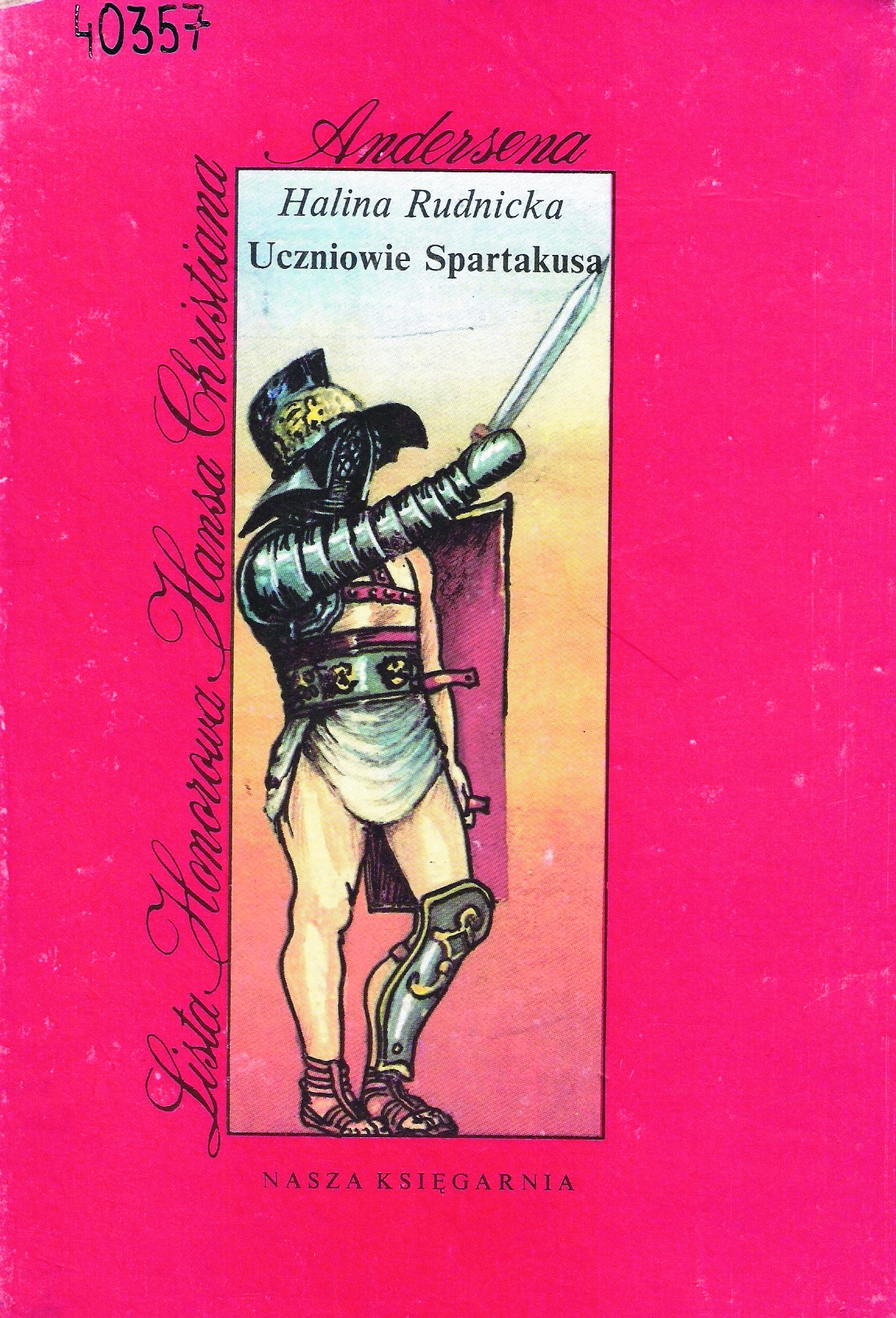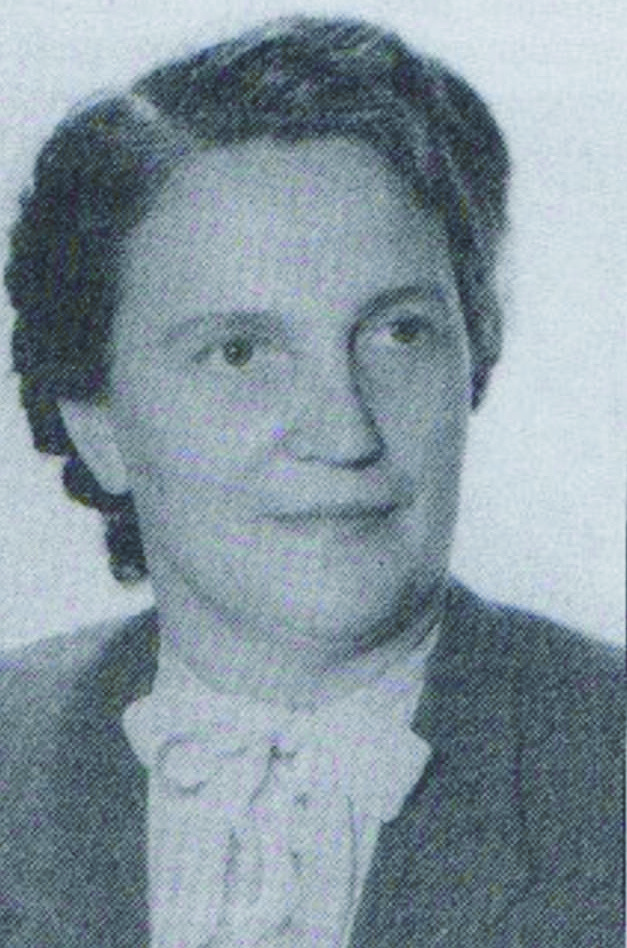Title of the work
Country of the First Edition
Country/countries of popularity
Original Language
First Edition Date
First Edition Details
Halina Rudnicka, Uczniowie Spartakusa. Warszawa: Nasza Księgarnia, 1951, 292 pp.
ISBN
Awards
1952 – Polish National Award (2nd Rank);
1951 – Orle Pióro (Eagle Feather) – a readers’ award for the most popular author of youngster’s literature (awarded by the readers of "Płomyk" – children’s journal).
Genre
Historical fiction
Novels
Target Audience
Crossover (Children, teenagers, young adults)
Cover

Graphical design by Krystyna Michałowska (Warsaw: Nasza Księgarnia, 1989 [ed. pr. 1951], 191 pp.). Courtesy of the publisher.
Author of the Entry:
Summary: Helena Płotek, University of Warsaw, helenaplotek@student.uw.edu.pl
Analysis: Marta Pszczolińska, University of Warsaw, m.pszczolinska@al.uw.edu.pl
Peer-reviewer of the Entry:
Katarzyna Marciniak, University of Warsaw, kamar@al.uw.edu.pl
Elżbieta Olechowska, University of Warsaw, elzbieta.olechowska@gmail.com

Photograph from Janusz Dębski’s archive.
Halina Rudnicka
, 1909 - 1982
(Author)
Born in Mława. A writer, publicist, educator, and author of textbooks. Most known for writing books inspired by Antiquity and aimed at young adults. Graduated from the University of Warsaw with MA in Polish philology. She later completed a post graduate degree in pedagogy. During the German occupation she took part in the underground education of Polish children. After WW2 she worked at the Ministry of Education right up to 1949, and then devoted herself to writing full time.
The beginning of her literary career coincided with the 5th Congress of Polish Writers at which social realism was imposed as the leading literary style. As a result, most of her books display a strong influence of the social realism. Her major works: Polną ścieżką [Through Field Path], 1949; Chłopcy ze Starówki [Lads from the Old Town], 1960 – books referring to WW2 and Nazi German occupation of Poland; Płomień gorejący [Ardent Fire], 1951 – a biography of Felix Dzerzhinsky aimed at young adults, and Wspomnienia o Janku Krasickim [Memoirs about Janek Krasicki], 1955 — a story of the young Polish activist and agitator for USSR. Rudnicka is also the author of Trylogia spartańska [Spartan Trilogy] — a series of three novels for young adults: Król Agis [King Agis], 1963; Syn Heraklesa [The Son of Heracles], 1966, and Heros w okowach [A Hero Bound], 1969.
She was the recipient of many Polish and international awards, e.g. the Polish National Award (2nd Rank) for her novel Uczniowie Spartakusa [The Disciples of Spartacus], 1951, the Prime Minister’s Award for her books for children and teens. In 1979 her novel Uczniowie Spartakusa gained a place on the Hans Christian Andersen Honour List.
Sources:
Janusz Dębski, "Halina Rudnicka – pisarka z Mławy", kuriermlawski.pl (accessed: February 21, 2013).
Hanna Kanigowska, "Patron", zpo2.mlawa.pl (accessed: June 11, 2021).
"Rudnicka Halina", in Julian Krzyżanowski, ed., Literatura polska. Przewodnik encyklopedyczny, vol. II: N–Ż, Warszawa: Państwowe Wydawnictwo Naukowe, 1985, 318–319.
Bio prepared by Helena Płotek, University of Warsaw, helenaplotek@student.uw.edu.pl
Translation
Czech: Spartakovi žáci, trans. Olga Olšarová, Praha: Státní naklad. dětské knihy, 1955.
Slovak: Malý gladiátor, trans. Božena Sedláková, Košice: Vychodoslovenské vydavatel'stvo, 1988.
Summary
Based on: Katarzyna Marciniak, Elżbieta Olechowska, Joanna Kłos, Michał Kucharski (eds.), Polish Literature for Children & Young Adults Inspired by Classical Antiquity: A Catalogue (accessed: June 11, 2021), Faculty of “Artes Liberales”, Warsaw: University of Warsaw, 2013, 444 pp., section by Helena Płotek, Joanna Grzeszczuk and Michał Kucharski, pp. 311–323.
Ancient Rome right before Spartacus’ uprising. The main character is a young Greek boy named Kalias. The story begins at a slave market where Kalias is being sold alongside his mother; she is sold to a wealthy patrician and Kalias to another patrician, Quintus Varinius. His first task is to help with a great feast at the house of Varinius. Unfortunately, he spills wine on an important guest and as punishment is sent off to be a pig herder; he decides to escape. After some adventures, he meets Marcus, the nephew of Quintus Varinius who knew about Kalias’ escape. Marcus tries to catch him but during the chase Kalias falls into a chasm. There he is found, wounded and near death, by Spartacus and Sotion. He is taken to the Gladiator School of Lentulus Batiatus in Capua where his wounds heal. He makes there many new acquaintances among the gladiators.
Many scenes show Kalias getting used to living in a school for gladiators until Spartacus launches his revolt against Roman oppression – which eventually becomes the historical Third Servile War. Kalias quickly joins Spartacus’ slave army – they flee Capua and head for Mount Vesuvius where they make camp awaiting the Roman army. The rest of the book describes the bitter fight of Spartacus and his fellow slaves against the Roman commander Marcus Crassus and his legions – in this part of the story, the social realism themes are fleshed out the most, highlighting the struggle of the impoverished strata of society against the opulent ruling class represented by the Roman patricians. The book closely follows historical facts ending with the defeat of Spartacus at the battle of the Silarius River and the subsequent crushing of the uprising by the Roman army. The surviving slaves are crucified along the Appian Way. Kalias and Sotion manage to escape with their life.
Analysis
The first edition's date is a very important piece of information in understanding why the author presents Roman Antiquity in this particular way. In communist Poland, following Karl Marx's view, Spartacus was regarded as an icon; a representative of the ancient proletariat, and a noble revolutionary in the class struggle. Although this approach is evident for an adult reader, for a child reading about the protagonist’s adventures in the ancient Roman world, these subtle and cleverly combined issues seem just right.
Besides historical events presented in the novel and the main characters' connected fates, social issues play an important role. The author begins with a strong and touching image of a Roman slave market and the tragic fates of captured people treated like cattle. Then, the slavery system is shown using a contrast between the lives of rich Romans and their slave servants. The author also describes free, but poor Romans expulsed from their properties because of debts and deprived of their patrimonial heritage. In this context, Spartacus’ idea of an independent civitas solis – a state of equality and brotherhood, freedom and justice, without the whip and violence – and the fight for freedom and equality, is here, a simple consequence of the Roman (i.e., oppressive) social system and the way it functioned. In a black-and-white convention, the Romans in the novel are all portrayed as villains, clearly depicted as vicious, ruthless, greedy, overbearing, or simply evil. Vibius/Milo, a Roman citizen and a cruel pirate at the same time, assassinates, kidnaps, mistreats and sells innocent people. Marcus is a spoilt and malicious teenager; Varinius spends a fortune maintaining his luxurious properties and entertainment style and expels peasants from his land out of greed; Batiatus abuses, whips and tortures gladiators and considers their general education as potentially dangerous. Rather than being a leader, Cossinus is lazy and self-indulgent; Verres is corrupted; Crassus (called Secator – “reaper”) is a villain and is said to epitomize all the flaws of the conquerors: greed, cruelty, intolerance, pride and arrogance. The Romans rule applying brutal discipline, flogging and decimating their own soldiers; they crucify over 30 thousand survivors of the 2nd slave war on Sicily. Their eventual victory over Spartacus’ revolt ends similarly – they crucify all the defeated warriors. The only Roman who gains the author’s respect is Furius – the father of a kidnapped-and-sold-into-slavery son – who, owing to this tragedy, can see people and not beasts in his opponents. And finally, having experienced the injustice of Rome joins the uprising to fight for a just world.
According to the same schematic black-and-white treatment, the behaviour of the other side of the conflict is flawless. Even at the gladiator’s school in Capua, Spartacus’ companion is extraordinary. They are close to each other, live in an atmosphere of friendship, try to get educated, discuss ideas instead of telling cruel stories, they debate the state according to Lycurgus or discuss wisdom according to Socrates. They plan to fight not for the right to live in luxury and pleasure, but the right to survive and get back their humanity. The sacred cause of all the wronged is not only revenge but freedom and justice. In the descriptions, there are sometimes terms known from slogans of Stalinist propaganda, full of stereotypes. All inappropriate behaviors in Spartacus’ camp, including taking food from farmers and slaughtering the inhabitants of Nuceria (Nocera), are only attributed to “others” – the Germans of Crixus or Celts, to preserve the moral superiority of the main characters. At the same time, this manner of writing suggests how functioned stereotypes used to describe Germans shortly after WW2.
The author tries to provide a complex social background and a cultural one, firmly rooted in historical sources. She depicts the everyday life and customs of Romans, seen from the perspective of Kalias, the child born in a different country. Rudnicka uses not only the major sources of facts like Plutarch or Appian of Alexandria, but also smaller pieces or fragments to add more authentic details, for example, original poems about a slave for sale, Greek songs, a song of gladiators*, Alcaeus’ poetry, Cato’s recipe for wine for slaves, or Josephus Flavius’ description of armour. Moreover, specific vocabulary connected to Roman nomenclature, customs and traditions is used.
Another important issue seems to be mythology and a potential effect of myth on the protagonist’s life. Kalias, when separated from his mother, hears from her that he must be as strong and brave as Heracles. It affects him, and he tries to be brave. At his most difficult moments, he calls upon the mythical hero, and when he lies exhausted and injured after a chase, he views the approaching Spartacus and Sotion as Heracles and his teacher Chiron. The two friends from Capuan gladiator school are called after Zeus’ divine twins Castor and Pollux because they are so close to each other that nobody remembers their real names. The myth of the duel between Achilles and Hector is mentioned, when a precious decorated goblet is offered to pirates and other items to pay for sailing to Sicily.
For many years the book was obligatory reading in the 5th grade (11-year-olds) curriculum, then it became optional. Currently, the book is not part of Polish primary schools curricula.
* Non te peto, piscem peto/ Quid me fugis, Galle?
Further Reading
Kanigowska, Hanna, "Patron", zpo2.mlawa (accessed: June 11, 2021).
"Rudnicka Halina", in Julian Krzyżanowski, ed., Literatura polska. Przewodnik encyklopedyczny, vol. II: N–Ż, Warszawa: Państwowe Wydawnictwo Naukowe, 1985, 318–319.
Čulik-Baird, Hannah, “Staging Roman Slavery in the Second Century BCE”, Ramus 48.2 (2019): 174–197.
Jędrych, Karolina, “Lektury w programach dla szkoły podstawowej z lat 1949—1989” in K. Heska-Kwaśniewicz, K. Tałuć, eds., Literatura dla dzieci młodzieży. T. 4, Katowice: Wydawnictwo Uniwersytetu Śląskiego, 2014, 205–224.
Sienko, Maria, Polonistyka szkolna w gorsecie ideologii: dyskusje wokół wychowania literackiego w latach 1944–1989, Kraków: Wydawnictwo Naukowe Akademii Pedagogicznej, 2002.
Addenda
Illustrators:
1951, 1952: Józef Czerwiński,
1954, 1955: Stanisław Rozwadowski,
1959: Andrzej Radziejowski,
1960, 1962, 1963, 1964, 1966, 1968, 1972, 1974, 1978, 1981: Tadeusz Szymon Kobyliński,
Editions 1986–2017 no illustrations (only graphical design, covers).


